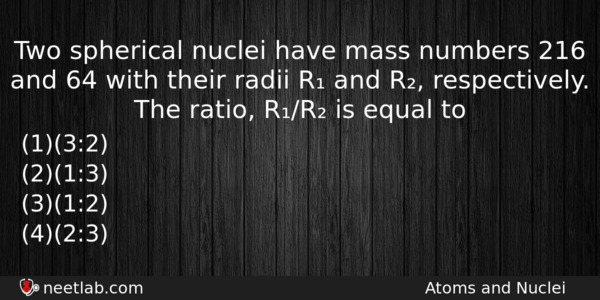| ⇦ | 
| ⇨ |
Two spherical nuclei have mass numbers 216 and 64 with their radii R₁ and R₂, respectively. The ratio, R₁/R₂ is equal to
Options
(a) (3:2)
(b) (1:3)
(c) (1:2)
(d) (2:3)
Correct Answer:
(3:2)
Explanation:
Radius of nuclei having mass number A is determined as
R = R₀ A¹/³ (where R₀ = constant)
where, R₀ = 1.2 x 10⁻¹⁵ m
This implies, R₁/R₂ = (A₁/A₂)¹/³ = (216/64)¹/³ = 6/4
R₁:R₂ = 3:2
Related Questions: - A boat is sent across a river with a velocity of 8 km/h.If the resultant velocity
- A source of unknown frequency gives 4 beats/s, when sounded with a source harmonic
- The capacitance of two concentric spherical shells of radii R₁ and R₂ (R₂>R₁) is
- A body covers 200 cm in the first 2 seconds and 220 cm in the next 4 seconds.
- A DC ammeter has resistance 0.1Ω and its current ranges 0-100A. If the range
Topics: Atoms and Nuclei
(136)
Subject: Physics
(2479)
Important MCQs Based on Medical Entrance Examinations To Improve Your NEET Score
- A boat is sent across a river with a velocity of 8 km/h.If the resultant velocity
- A source of unknown frequency gives 4 beats/s, when sounded with a source harmonic
- The capacitance of two concentric spherical shells of radii R₁ and R₂ (R₂>R₁) is
- A body covers 200 cm in the first 2 seconds and 220 cm in the next 4 seconds.
- A DC ammeter has resistance 0.1Ω and its current ranges 0-100A. If the range
Topics: Atoms and Nuclei (136)
Subject: Physics (2479)
Important MCQs Based on Medical Entrance Examinations To Improve Your NEET Score
18000+ students are using NEETLab to improve their score. What about you?
Solve Previous Year MCQs, Mock Tests, Topicwise Practice Tests, Identify Weak Topics, Formula Flash cards and much more is available in NEETLab Android App to improve your NEET score.
Share this page with your friends

R=R°A^1/3. (R°=constant
R1÷R2 =(A1÷A2)^1/3
=(216÷64)^1/3
=6÷4.
=> R1:R2 = 3:2